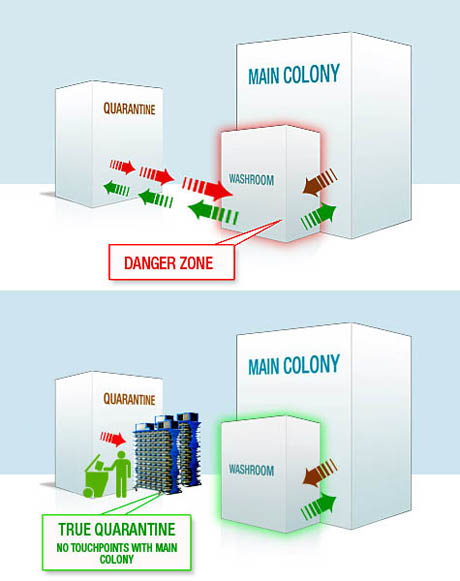
President Richard Nixon addressing quarantined Apollo astronauts; photo courtesy of NASA.
I’m very excited to announce my husband (Geoff Manaugh of BLDGBLOG) and I will be hosting a design studio called Landscapes of Quarantine in New York City this autumn – with the resulting projects to be displayed in a public exhibition at the Storefront for Art and Architecture in early 2010.
Meeting one evening a week in Manhattan, from October 6 to December 5, 2009, up to 14 participants will discuss the spatial implications of quarantine and then develop an individual design project in response to the studio theme. Quarantine is an ancient spatial practice, characterised by enforced immobility, decontamination, and sequestration, which goes back at least to the Black Death – if not to Christ’s 40 days in the desert. Yet it has re-emerged as an issue of urgent biological, political, and even architectural importance in our era of global trade, bio-engineering, and mass tourism.

“Fear of Flu” by Mike Licht.
Quarantine touches on constitutional issues of state power and a government’s authority to enforce involuntary medical isolation, as well as the limits of inter-state jurisdiction. It is as much a matter of biodiversity, medical safety, and national security as it is an entry point into discussions of race, purity, and unacknowledged discrimination.
Quarantine is a plot device increasingly seen in novels and films – from the aptly named Quarantine to I Am Legend and The Last Town on Earth – even as it has become a source of arcane technical debate within plans for Martian exploration and Antarctic drilling.
The design implications of quarantine stretch from the ballast water of ships to the way we shape our cities, from the wooden souvenirs in a traveller’s suitcase to stray seeds stuck in a hiker’s boot treads. Quarantine affects the pets we keep, the programs we download, and the machines we use in food-processing warehouses, worldwide.
Quarantine is about managing perimeters, controlling influence, and stopping contamination.

Cages for the laboratory testing of rats and mice by Innovive.
So how do we address quarantine as a design problem?
Whether we design something to demonstrate that the very notion of quarantine might not be possible; whether we produce actionable plans for quarantine units, ready for implementation by the World Health Organization in hot zones around the world; whether we create quarantine themed graphic novels, barrier-based urban games, or a series of ironic public health posters to be mounted around the city, how can we design for quarantine?
Quarantine also offers fertile territory for investigation through cartography and cultural documentation. After all, if we mapped the contents and locations of quarantine facilities worldwide, designed infographics to analyse the spread of invasive species, or recorded the oral histories of the quarantined, what sorts of issues might we uncover?
Bringing these very different techniques, media, and approaches together in the confines of a dedicated design studio will give participants an exciting opportunity to explore the overlooked spatial implications of quarantine.

A poster for Quarantine, directed by John Erick Dowdle.
We have already confirmed a fantastic list of participants whose backgrounds include architecture, photography, illustration, games design, sound, landscape, food, and more; we are now opening the studio to a general call for interested participants. The brief – which you can download here as a PDF – explains more, but for potential applicants: this is an opportunity to work with a truly stellar group and produce a project eligible for inclusion in the “Landscapes of Quarantine” exhibition to be held at the Storefront for Art and Architecture in early 2010.
Some more details (again, explained in full in the brief):
- The studio will consist of eight Tuesday evening workshops between October 6 and December 5, 2009, and at least three Saturday meetings.
- During the studio, each participant will develop an individual design project in response to the problem of quarantine, with guidance and inspiration provided by readings, screenings, group discussions, and an evolving line-up of guest speakers and critics.
- By the end of the studio, each participant will have produced a complete design project. This could range from the speculative (plug-in biosecurity rooms for the American suburbs) to the documentary (recording the items and animals detained for quarantine on the U.S./Mexico border), and from the fantastical (plans for extra-planetary quarantine facilities) to the instructional (a field guide to invasive species control).
- Landscapes of Quarantine is looking for applicants who are intrigued by the spatial possibilities and contingencies of quarantine, and who already possess the technical skills necessary to produce an exhibition-quality final design project or installation in their chosen medium. We hope to hear from people at all stages of their careers—from graduate school to retirees—and from a wide variety of design backgrounds.
- The studio is unaffiliated and independent (there is no university credit), and it is also free (though applicants will be responsible for all costs associated with producing their final project).
- We will be reviewing applications on a rolling basis until Friday, September 18, 2009, or until all studio positions have been filled.
- Landscapes of Quarantine is produced and organized by Future Plural, a project-based independent design lab launching in October 2009 from a temporary base in New York City. Future Plural consists of Geoff Manaugh (BLDGBLOG) and Nicola Twilley (Edible Geography).
So, if you are interested, please download the brief – which lists all the information to submit with your application – and contact us at futureplural @ gmail.com by September 18, 2009.

Australian quarantine signage.
Finally, a major motivation behind starting Future Plural and hosting the Landscapes of Quarantine studio is to found a new type of institution, one without a permanent location, dependence on grants, or academic affiliation. After all, as bloggers, why can’t we create our own research groups, faculties, cultural spaces, exhibitions, events, and more? By bringing people together on a project-by-project basis, to explore ideas and issues in a cross-disciplinary environment, we hope to demonstrate that, even in a time of recession, there is a broadly shared enthusiasm for creating something new.
[NOTE: This post was co-authored by Geoff and I, and posted simultaneously on BLDGBLOG and Edible Geography.]
